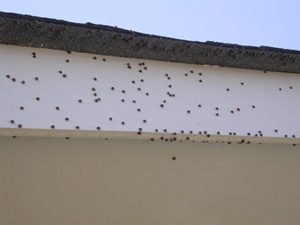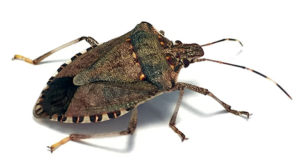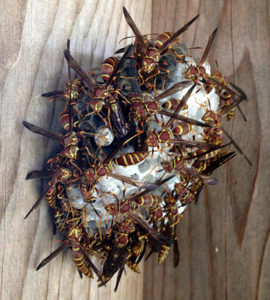 Mosquitoes can put a damper on outdoor activities. Spraying pesticides to control mosquitoes can help, but it needs to be done carefully and not endanger ourselves, our families and our environment. Here are some tips for doing this safely and smartly.
Mosquitoes can put a damper on outdoor activities. Spraying pesticides to control mosquitoes can help, but it needs to be done carefully and not endanger ourselves, our families and our environment. Here are some tips for doing this safely and smartly.
Author Archives: Michael Waldvogel
Bed Bugs Modify Microbiome of Homes They Infest
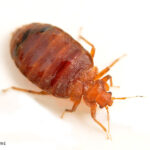 Using floor dust samples were collected from apartments Raleigh, N.C. Researchers at North Carolina State University showed that homes infested by bed bugs appear to have different bacterial communities – often referred to as “microbiomes” – than homes without bed bugs. These microbiomes can impact on the air quality within the apartments and can affect residents of those apartments.
Using floor dust samples were collected from apartments Raleigh, N.C. Researchers at North Carolina State University showed that homes infested by bed bugs appear to have different bacterial communities – often referred to as “microbiomes” – than homes without bed bugs. These microbiomes can impact on the air quality within the apartments and can affect residents of those apartments.
Asian Hornets – Not A Problem in North Carolina
(Note: This is a modified version of a post we have on the NC Cooperative Extension website.)
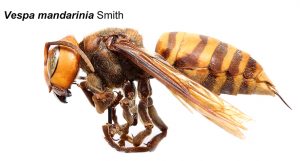
Asian giant hornet (Matt Bertone, NC State University)
The news media have been reporting that the Asian giant hornet (Vespa mandarinia) has been found in Washington state. This actually happened back in late 20191. Previously, it had been reported in British Columbia, Canada in September 2019. This hornet lives up to its name because the queens are more than 2″ long while the workers are about 1 1⁄2″ long. The “murder hornet” nickname has been attributed to them being responsible for the death of 50 people annually in Japan, much the same way that the term “killer bees” was applied to the Africanized honey bees as it made its way up from South & Central America and into the southern U.S. What is also true is that these giant wasps have a well-deserved reputation as a pest because they attack and can destroy entire bee colonies.
It’s extremely important to understand that this insect is not found in North Carolina and we have little reason to suspect it is present here (or will be present any time soon). However, over the years, we have received numerous calls and emails from people about finding “Japanese Hornets.” and the same is happening right now. In every case, what people were seeing were European hornets, Vespa crabro, which is no wimp itself.
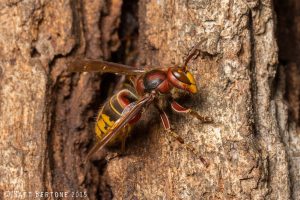
European hornet worker (Matt Bertone, NC State)
Adult European hornets somewhat resemble yellowjackets, but are much larger (about 1 1⁄2″) and are brown with wide yellow markings. Queens of the Asian giant hornet are more than 2″ long while the workers are about 1 1⁄2” long (see image below). The Asian giant hornets have an almost entirely yellow-orange colored head. They have a dark thorax (the body section where the wings and legs attach) and the abdomen has dark brown and black bands. The head of European hornet (seen below) is reddish-brown, becoming yellowish near the face. Also, the eyes of Asian giant hornets are smaller in relation to the size of the head compared to European hornets.
European hornet queens are busy building nests which may be hidden in hollow sections of a tree trunk or in attics. If you see large wasps entering holes/gaps in roof fascia and soffits or going under decks, Although it will take several weeks for the numbers of new workers to start increasing, NOW is the time to act before their colonies begin to grow and produce workers that will defend the nest aggressively (based on first-hand experience!). Watch for signs of wasp activity in and around your home. According to data publish by the CDC for the years 2000-2017, an average of 62 people died annually from bee/wasp/hornet stings in the U.S. with about 80% of those cases being males. A study2 published in 2014 estimated that there are about 220,000 ER-visits annually due to bee and wasp stings.
Asian giant hornets are not an issue for us at this time and not likely to be one in the near future barring some accidental introduction (as was likely the case in Washington). However, everyone needs to be aware that we have a resident hornet species that, at first glance, appears similar to the Asian giant hornet. As with any bee/wasp/hornet sting, the greatest threat is for people who are highly allergic need to be careful outdoors. Regardless of whether or not you are sensitive to such stings, always be careful and watch for signs of bee/wasp activity. Use caution when approaching a wasp/hornet nesting site and be careful when working outdoors on items that have not been disturbed for some time (like piles of wood). If you find a wasp that fits the description of the Asian giant hornet, contact your local County Cooperative Extension Center
You can also submit images online to the NC Plant Disease and Insect Clinic (NCPDIC).
If you are a beekeeper, you can check out Asian Giant Hornets Not a Problem for NC Beekeepers…yet? by Dr. David Tarpy.
You can also read a blog post by Dr. Matt Bertone, Director of the NC Plant Disease and Insect Clinic. Plus, we have information about the European Hornets in North Carolina.
Reference cited:
2/ New Pest Response Guidelines – Asian Hornet, Vespa mandarinia. USDA-APHIS
2/ Langley, R.L., Mack, K., Haileyesus, T., Proescholdbell, S., and Annest, J.L. National estimates of noncanine bite and sting injuries treated in US hospital emergency departments, 2001–2010. Wilderness Environ Med. 2014; 25: 14–23>
Termites Swarming
Rain across many areas of North Carolina over the next few days followed by warmer temperatures will likely bring about a surge in termite swarm begin. Most termites in a colony are wingless. However, at this time of year, we see a new batch of winged reproductives (future queen and king termites) who will build new colonies (See Termite Swarmers – What Do They Mean for You?). Aside from having wings, swarmers look different from the colony’s worker termites which are wingless and white in color. Swarmers are dark in color and more resemble what many people call “flying ants” (which is a generic term for the reproductives of any number of ant species). The easiest way to distinguish winged termites from winged ants is that ants have a “thin waist” similar to wasps.

Shed termite wings on a window ledge are likely a sign of a infestation in the home
Termites typically swarm during the daytime and often after rains. They appear suddenly and may be around for a few hours and then suddenly disappear. Very often, the only sign of their activity are their shed wings scattered about the area (as seen in the image here). If swarmers are seen outdoors, take it as nature’s way of reminding you that termites live all around us. HOWEVER, that does not necessarily mean that they’re invading our homes. The solution? Take the hint and consider contacting a pest management professional to inspect your home to look for any other sign of termite activity. This can be particularly helpful if your home has not been treated or inspected for more than 8-10 years. If termites swarm inside your home, this more likely means that you’re hosting a family of several thousand termites. If you have a termite contract, contact the pest management company immediately and arrange for an inspection. If you don’t have a contract, it is best to contact 2-3 companies and have them inspect your home and give you an assessment of any problems and how they propose treating it.
With termites, a “do-it-yourself” approach is probably not a good choice. Termite treatments include the use of a liquid insecticide applied to the soil and/or the use of an in-ground termite baiting system. The choice of treatment may be a matter of your preference or dictated somewhat by the type of construction of your house (e.g., crawlspace, slab or basement) and other factors such as foundation drains or encapsulated crawlspaces. We don’t recommend one type of treatment over another. The best piece of advice we can give you is to take your time and compare the treatment proposals in terms of the method of treatment, the cost of the treatment, and the terms of the warranty that the company provides. Most contracts are renewed annually and come with an annual fee of $125 – $350 (depending on the type of treatment you have). Termites are not going to cause significant damage in the 7-14 days that you might use to make your decision on how best to protect your home and. In many cases, the company may have to schedule you 1-2 weeks out anyway as they get busier at this time of year.
For more information about controlling termites, click HERE
Fall Invaders
The following was cross-posted from the Extension Entomology website.
In spite of our continued warm weather, several of our typical cool-weather pests have begun their fall invasion of homes and commercial buildings. This is actually not surprising since this move to seek overwintering sites is due not just to temperature but also the shortening day-length and decline in suitable food plants.
Kudzu bugs are moving out of kudzu and soybean fields and flying to nearby structures, particularly those with light-colored siding (as seen in the figure to the right). As many people discover, spraying siding, window trim, etc. is likely to produce mediocre results even if repeated sprays are applied. Many of the labels for the pyrethoid pesticides (those containing chemicals such as lamda-cyhalothin, cyfluthrin, bifenthrin, etc.) also limit their application to vertical areas above impervious surfaces (such as driveways, sidewalks, patios) where rain could wash the chemical off the treated surfaces and allow them to run off into storm drains. We have additional information at:
Brown Marmorated Stink Bugs (BSMB) are also making their presence known across the state, particularly in the Piedmont, Foothills, and western NC. This pest causes significant damage to a wide variety of fruit, vegetable and row crops as well as ornamentals. Although control is possible for these crops, preventing the stink bug’s invasion of homes is difficult. As with kudzu bugs, surface sprays to building exteriors or around windows and doors is rarely effective.
For more information about BMSB, visit:
- Brown Marmorated Stink Bug in the Landscape and in the Home
- Brown Marmorated Stink Bug (North Carolina)
Paper Wasps (Polistes sp.) colonies reached their peak size a few weeks ago with the production of next year’s queens and are now starting to disperse. Although the workers and this year’s queen will die over the next few weeks, some workers along with next year’s queens will abandon their nests and look for overwintering sites. This activity often results in wasps finding gaps near chimneys or roof ridge vents or windows and doors and then showing up indoors. Many people assume that there is an active nest inside a wall or some other hidden area (e.g., attached to the underside of a deck).
However, the wasps could also be coming from nests out in storage buildings, tree holes, firewood piles, old unused cars, or other items that have been undisturbed for much of the summer. Spraying the exterior of the building (not spraying a specific nest) is not going to keep this activity which will continue until we see cold (frost). Even then, warm winter days may cause the wasps to become active. Bear in mind that there is not a functioning nest and so the wasps are not aggressively defending a nest. However, if you step on one or swat at one, it may sting in defense..
We have more information at: Controlling Paper Wasps in and Around Structures
Mike Waldvogel and Patty Alder, NC State University Extension


